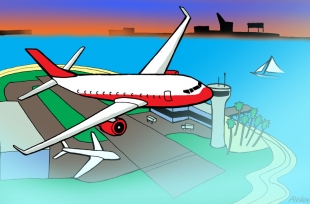 One bold idea that seems to have the greatest diversity of voices is that of a waterfront airport. In 1980, the Southern California Association of Governments (SCAG) began a feasibility study of developing an artificial island south of the port complexes for a new offshore airport. As Long Beach’s Naval Shipyard was being decommissioned in the nineties there were those in the community who wanted to see it converted into a new airport. Most recently Fifth District City Council Candidate proposed building a floating island to serve as an offshore airport. For the discussion of the Ten Bold Ideas the conversation again picked up moving the current airport in or near the water.
One bold idea that seems to have the greatest diversity of voices is that of a waterfront airport. In 1980, the Southern California Association of Governments (SCAG) began a feasibility study of developing an artificial island south of the port complexes for a new offshore airport. As Long Beach’s Naval Shipyard was being decommissioned in the nineties there were those in the community who wanted to see it converted into a new airport. Most recently Fifth District City Council Candidate proposed building a floating island to serve as an offshore airport. For the discussion of the Ten Bold Ideas the conversation again picked up moving the current airport in or near the water.
Theories have varied from locating it within the port complex to a completely stand alone artificial island connected to the mainland by bridge or tunnel. Planes would either take-off and land entirely over water in an east-west direction, or do so over water and up to nine miles of port facilities, industrial and extraction properties in the north-south direction. Air and noise pollution would largely be isolated to the immediate port complex while potentially allowing more commercial air traffic in the city.
The logic of creating this seaside airport would be to replace the current one which is surrounded by urban development. The current airport has less than a half mile of clearance from either end of the main runway becoming a growing source of friction between the city who owns and operates the facility and the surrounding residential neighborhoods. When urban development encroached on Austin and Denver’s regional airports they built replacements far away from any adjacent development. The combined port complex and adjacent industrial area is one of the largest contiguous areas devoid of residential neighborhoods in the Los Angeles Basin, making it the most suitable location for such a replacement airport.
SCAG’s study for the new offshore airport met fierce resistance from residents, whose primary concern was the volume of land reclamation needed for the artificial island. While the high-concept of a floating airport could mediate that apprehension, growing realization of Pier J’s impact on local water quality would likely make new offshore footprints a significant public concern. With those concerns the path of least resistance for developing a replacement airport might be to do so within the existing boundaries of the Port of Long Beach.
One configuration would be to reclaim the west basin of the Port of Long Beach and realign Pier T, providing sufficient area for a terminal and pair of two mile long north-south oriented runways, creating the second largest airport in the region. Like the Port’s Middle Harbor project as well as waterfront airports in Boston and San Francisco, they just looked to the waterfront to find…make the large plots of land. If another bold idea goes as planned, tens of thousands of cubic yards of rock could be available from reconfiguring the breakwater to create this new land for the waterfront replacement airport.
Beyond the quality of life issues for those adjacent to the current airport, this move would create tremendous economic development for the adjacent waterfront communities. Long Beach’s centrality to the region provides an ideal location for tourists to stay while visiting destinations throughout Southern California but the current airport’s convenient freeway access allows visitors to use the facility while avoiding the city almost entirely. Instead, due to their proximity to the new airport, downtown Long Beach (and San Pedro) could experience significant increases to hospitality and tourism as the nearest nodes of activity, spurring massive amounts of economic development; including more hotels, new commercial office space and yes, even shopping.
A new waterfront airport would have an incredible impact on Long Beach, from quality of life to economic growth. This bold idea is often met with skepticism, so much so that the concept is discounted outright, but time should be dedicated to thoroughly analyzing the concept. Removing the current airport operation will benefit residents on the Eastside as well as North Long Beach while a new airport in the port complex would greatly serve the growth of downtown’s economic base. There seems to be few things that residents on the Eastside and the Downtown can agree on, perhaps this is one time that it would happen.
Illustration by Andrew Wilson
UPDATE: Here’s a map that may help you visualize the site:


